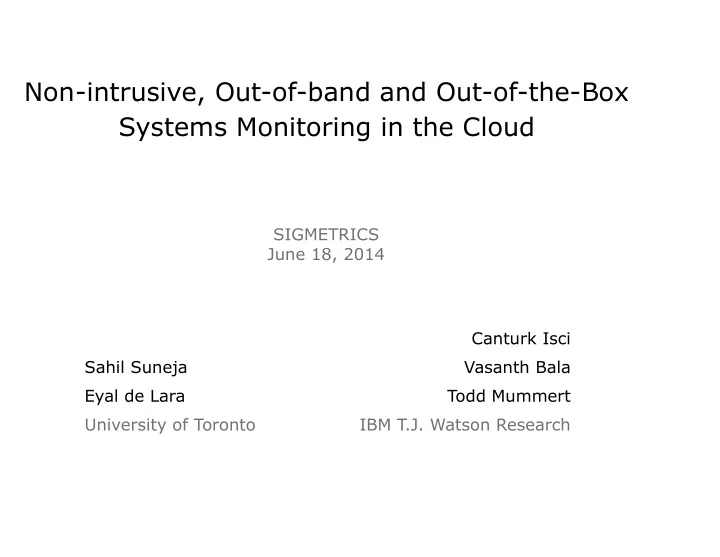

Non-intrusive, Out-of-band and Out-of-the-Box Systems Monitoring in the Cloud SIGMETRICS June 18, 2014 Canturk Isci Sahil Suneja Vasanth Bala Eyal de Lara Todd Mummert University of Toronto IBM T.J. Watson Research
IBM Research Data Center Machines Traditional VMs = new processes for the cloud computer! OS HARDWARE Modern 2
IBM Research Traditional Systems Monitoring 3
IBM Research Traditional Systems Monitoring VM VM VM VM VIRTUALIZATION LAYER HARDWARE 4
IBM Research Introducing- Near Field Monitoring VM VM VM VM VIRTUALIZATION LAYER HARDWARE 5
IBM Research Near Field Monitoring (NFM) 6
IBM Research NFM's Advantages Always-on: Works for unresponsive or compromised systems Out-of-the-box: Unmodified guest No agent or hook installation Non-intrusive: No guest cooperation No interference with guest operation Out-of-band: Outside guest's context Decouple execution and monitoring Virtualization-aware: Holistic knowledge Accurate and efficient monitoring 7
IBM Research NFM's Architecture Hypervisor Cloud Analytics Analytics Apps VM OS APP Memory Crawl Frames API Frame { Crawl Datastore ....... Disk MEM MEM APP ....... Logic Frontend Backend Structured } View view of Disk Disk VM states Crawl View APP API Frontend Backend 8
IBM Research Approach: VM Memory Introspection Hypervisor VM OS Memory Crawl API Crawl Disk MEM MEM Logic View Disk Disk Crawl View API 1. Exposing VM Memory State – Gain access to VM’s memory image from outside • Unmodified VM • Unmodified hypervisor 2. Exploit VM Memory State – Reconstruct VM's runtime state from the memory image – In-memory kernel data structure traversal 9
IBM Research Approach | Exposing VM Mem State Memory dump – Dump / migrate guest memory to file – KVM-QEMU pmemsave or migrate- to-file – High overhead: VM paused for dump duration Live R/O memory handle – Xen • Map guest memory into crawler process- xc_map_foreign_range() – KVM • No default support • New live handle, read VM mem directly via – QEMU process' /proc/<pid>/mem + /proc/<pid>/maps – Negligible impact on VM 10
IBM Research Approach | Exploiting VM Mem State Extract system information by traversing linux kernel's C structs in exposed memory image – Different structs for different kinds of information • task_struct, mm_struct, files_struct, net_device etc. Requirements: – Starting addresses for structs • /boot/System.map – Offsets for particular struct fields • Linux source or vmlinux • /boot/<Build.config> 11
IBM Research Backend | Crawl Output Cloud Analytics Analytics Apps APP Frames Frame VM { Crawl Datastore ....... Mem/Disk APP ....... Logic Structured handle } view of VM states APP CPU NumCores, Hz, CacheSize, ... OS Nodename, Release, Arch, ... N/W device HWaddr, Ipaddr, TX/RX bytes, ... Modules Name, State, ... Process PID, Command, RSS, ... Open files FD → filename, ... Memory Mapping MappedFiles, VA → PA mappings, ... N/W connections SocketState, {Src, Dst, Ports}, ... 12
IBM Research Backend | Prototype Apps 1. CTop : Cloud-wide consolidated resource monitoring 2. PaVScan : Hypervisor paging aware virus scanner 3. RConsole : Remote console 4. TopoLog : Network topology discovery 13
IBM Research Evaluating NFM Latency / monitoring frequency? Accuracy? Overhead? Advantages? 14
IBM Research NFM's High Monitoring Frequency Safe: 10Hz KVM: 20Hz Xen: 200Hz Basic Crawl Full Crawl 15
IBM Research NFM's Accuracy: Cloud Top vs. top top – 11:58:42 up 1 day, 22:19, 1 user, load average: 0.90, 0.22, 0.11 Tasks: 57 total, 3 running, 54 sleeping, 0 stopped, 0 zombie Cpu(s): 99.0%us, 0.0%sy, 0.0%ni, 0.0%id, 0.0%wa, 0.7%hi, 0.0%si, 0.3%st Mem: 2052104k total, 1976340k used, 75764k free, 3996k buffers Swap: 6160380k total, 304068k used, 5856312k free, 1868k cached top | PID USER PR NI VIRT RES SHR S %CPU %MEM TIME+ COMMAND 1942 root 20 0 1028m 1.0g 188 R 49.9 51.0 0:08.98 malloc 1940 root 20 0 1028m 780m 136 R 49.5 38.9 0:11:91 malloc 1 root 20 0 56220 1164 408 S 0.0 0.1 0:00.71 systemd 2 root 20 0 0 0 0 S 0.0 0.0 0:00.00 kthreadd ----------------------------------------------------------------------------------------------------- Every 0.5s: ./topUpdate.sh CPU up time: 4461430125 jiffies cTop PID VIRT RES %CPU %MEM TIME+ COMMAND PID VIRT RES %CPU %MEM TIME+ COMMAND 1942 1052704KB 1047368KB 45.8 51.0 0:08:33 malloc 1940 1052704KB 798816KB 45.8 38.9 0:11.92 malloc 1 56220KB 1164KB 0.0 0.1 0:00.70 systemd 2 0 0 0.0 0.0 0:00.00 kthreadd : 16
IBM Research NFM's High Accuracy <4% variation 17
IBM Research NFM's Low VM Overhead 12000 9 Reply rate | 512MB WS Response time | 512MB WS 8 10000 Response time [ms] 7 8000 6 Reply rate [/s] 5 6000 4 4000 3 2 2000 1 0 0 base 10Hz monitoring virusscanning hashing + 256MB WS in paper 18
IBM Research NFM's Advantages: Analyze Dysfunctional Systems Via RConsole - Out-of-band console-like R/O interface Supported functions: ls, lsmod, ps, netstat, ifconfig, ... Time travel: sync and seed APIs Analyzes unresponsive systems : kernel panic, misconfigured n/w Detects (some) rootkits: In-VM Console: Active Internet connections (servers and established) Proto Local Address Foreign Address State tcp 127.0.0.1:25 0.0.0.0:* LISTEN tcp 9.XX.XXX.110:52019 9.XX.XXX.109:22 ESTABLISHED : tcp 9.XX.XXX.110:22 9.XX.XXX.15:49845 ESTABLISHED RConsole: Active Internet connections Proto Local Address Foreign Address State PID Process tcp 127.0.0.1:25 0.0.0.0:0 SS_UNCONNECTED 741 [sendmail] tcp 9.XX.XXX.110:52019 9.XX.XXX.109:22 SS_CONNECTED 6177 [ssh] : tcp 9.XX.XXX.110:22 9.XX.XXX.15:49845 SS_CONNECTED 14894 [sshd] tcp 0.0.0.0:2476 0.0.0.0:0 SS_UNCONNECTED 23304 [datacpy] 19
IBM Research NFM's Advantages: Better Accuracy Distributed Application – 3 LAMP instances VM1 VM2 VM3 Reservation 30% 30% 30% Allocation 100% 70% 30% 20
IBM Research NFM's Advantages: Better Accuracy
IBM Research Conclusion Current monitoring techniques unfit for modern virtualized Cloud Introducing Near Field Monitoring- Leverage virtualization for a fundamentally different VM monitoring approach Eliminates in-VM hooks, provides same fidelity monitoring out-of-band – Decoupled VM monitoring - execution architecture – Alleviates concerns with existing techniques – • Always-on, non-intrusive, holistic view, ... – Evaluation: High frequency ● Low overhead ● Better accuracy ● Higher efficiency ● 22
Recommend
More recommend